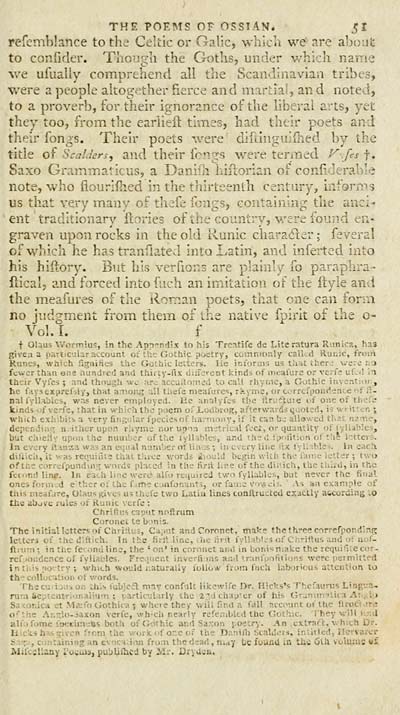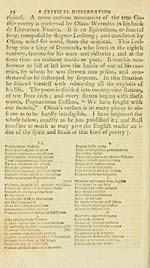Download files
Complete book:
Individual page:
Thumbnail gallery: Grid view | List view

THE POEMS OF OSSIAN. ^I
refenihhnce to the Celtic or Galic, wliicli we are abojt
to confider. Tliougli the Goths, under which name
we ufually comprehend all the Scandinavian tribes,
were a people altogether fierce and marLia!, an d noted,
to a proverb, for their ignorance of the liberal arts, yet
they too, from the eariieft times, had their poets and
their fongs. Their poets were difdnguifned by the
title of ScaUers, and their fongs were termed F.fes f.
Saxo Grammaticus, a Danifn hiflorian of confiderable
note, who fiourifhed in the thirteenth century, infarnTs
us that very many of thefe fongs, containing the anci-
ent traditionary ilories of the country, were found en-
graven upon rocks in the old Runic chara6ler ; feveral
of which he has tranflated into Latin, and inferted into
his hiilory. But his verfions are plainly fo paraphra-
flical, and forced into fuch an imitation of the ftyle and
the meafures of the Roman poets, that one ca,n form
no judgment from them of the native fpirit of the o-
Vol. I. f
t Glaus V»'ormius, in the ApTi-ndix to his Treatife de Lite ratura Riinica, has
givea a uarlicuUr account ot" the Gothic poetry, commonly called Runic, from
Runes, which fignifies the Gothic letters. He informs us that there were na
fewer than ene hundred and thirty-fix diiicrent kinds of nieafure or \'e.r\i ufcd in
their Vyfes ; and though we arcaccailomed to call rhyme, a Gothic invention,
he fayscjtprefsly, that among all thefe meafures, rX; rue, or c; i rcfiiorit'^n-e of fi-
nal fyllables, was never employed. Ee analvf ■ ''• ■ '' '•. ••■' ■ ' ■'••- -f 'hofs
kinds of verfe, that in which the poem of I-oc!;..' '"■ »
which exhibits a very fiiigular fpecies of harm ■ ■■-•,
deiicndiii!^ n.ithcr upon riiyme nor up'in in • cs,
but chieliy up<in the number of the lyllabSes, c. cis.
In every ftanza was an equal number of lines •, m c -i y iiic x ! ■ ;. i u- . m cac\
difticii, it was requifile that thwe v.-ords ihoulj btgir. wiLi. tho laii.t; .^itor ; two
of tee correfpondiiis words placed in the firll line of the diitich, the third, in the
fecund lin^. In each line werd alfo required two fyllables, but never the final
ones formed e'ther of the fame confonants, or fame voytcis. ' .As &n example of
tliis meafare, Olaus gives us thefe two Latin lines conftructed exatlly according .o
the above rules of Runic verfe :
Chriftus caput noflrum
Coronet te bonis.
The initial letters of Chriltus, Caput and Coronet, make the three correfponding
letters of the diftich. In the firll line, che iirft fyllables of Chriftus and of uof-
ftrum; in the feconiiline, the 'on' in coronet and in boni«niake the requifitecor-
rcf;iOi:dcnce of fyliables. Frequent inverfi.ins acl tranfpofilions were permitted
ir. t; =s po- try ; which Would naturally follow from fnch laborious attention to
ifj Jiis lubjcdlmayconfult likewife Dr. Hicks'sThcfaurusLingfa-
r ... ■'i''i!n; particularly the 43d chapter of his Grammalica Arijilp
. Gothica 5 where they will find a fall account of the firuftjTe
c. : . .i - ,i;(.n verfe, which nearly refembied the Gothic. They will lind
ail iDnic ;a>:ni:i-ios both of Gothic and Sa.xon poetry. An cxtrart, which Dr.
ii.ciihi^s given from the work of or.e of the Danilh Scaldors, inliiled, Ilcrvarcr
Sn^rf, containing an evocHlion fro.ni the dead , n.ay be foUflU in thii Glh voluius •£
MifccUany I'ovius, puUliflxed by Mr. Diydea.
refenihhnce to the Celtic or Galic, wliicli we are abojt
to confider. Tliougli the Goths, under which name
we ufually comprehend all the Scandinavian tribes,
were a people altogether fierce and marLia!, an d noted,
to a proverb, for their ignorance of the liberal arts, yet
they too, from the eariieft times, had their poets and
their fongs. Their poets were difdnguifned by the
title of ScaUers, and their fongs were termed F.fes f.
Saxo Grammaticus, a Danifn hiflorian of confiderable
note, who fiourifhed in the thirteenth century, infarnTs
us that very many of thefe fongs, containing the anci-
ent traditionary ilories of the country, were found en-
graven upon rocks in the old Runic chara6ler ; feveral
of which he has tranflated into Latin, and inferted into
his hiilory. But his verfions are plainly fo paraphra-
flical, and forced into fuch an imitation of the ftyle and
the meafures of the Roman poets, that one ca,n form
no judgment from them of the native fpirit of the o-
Vol. I. f
t Glaus V»'ormius, in the ApTi-ndix to his Treatife de Lite ratura Riinica, has
givea a uarlicuUr account ot" the Gothic poetry, commonly called Runic, from
Runes, which fignifies the Gothic letters. He informs us that there were na
fewer than ene hundred and thirty-fix diiicrent kinds of nieafure or \'e.r\i ufcd in
their Vyfes ; and though we arcaccailomed to call rhyme, a Gothic invention,
he fayscjtprefsly, that among all thefe meafures, rX; rue, or c; i rcfiiorit'^n-e of fi-
nal fyllables, was never employed. Ee analvf ■ ''• ■ '' '•. ••■' ■ ' ■'••- -f 'hofs
kinds of verfe, that in which the poem of I-oc!;..' '"■ »
which exhibits a very fiiigular fpecies of harm ■ ■■-•,
deiicndiii!^ n.ithcr upon riiyme nor up'in in • cs,
but chieliy up<in the number of the lyllabSes, c. cis.
In every ftanza was an equal number of lines •, m c -i y iiic x ! ■ ;. i u- . m cac\
difticii, it was requifile that thwe v.-ords ihoulj btgir. wiLi. tho laii.t; .^itor ; two
of tee correfpondiiis words placed in the firll line of the diitich, the third, in the
fecund lin^. In each line werd alfo required two fyllables, but never the final
ones formed e'ther of the fame confonants, or fame voytcis. ' .As &n example of
tliis meafare, Olaus gives us thefe two Latin lines conftructed exatlly according .o
the above rules of Runic verfe :
Chriftus caput noflrum
Coronet te bonis.
The initial letters of Chriltus, Caput and Coronet, make the three correfponding
letters of the diftich. In the firll line, che iirft fyllables of Chriftus and of uof-
ftrum; in the feconiiline, the 'on' in coronet and in boni«niake the requifitecor-
rcf;iOi:dcnce of fyliables. Frequent inverfi.ins acl tranfpofilions were permitted
ir. t; =s po- try ; which Would naturally follow from fnch laborious attention to
ifj Jiis lubjcdlmayconfult likewife Dr. Hicks'sThcfaurusLingfa-
r ... ■'i''i!n; particularly the 43d chapter of his Grammalica Arijilp
. Gothica 5 where they will find a fall account of the firuftjTe
c. : . .i - ,i;(.n verfe, which nearly refembied the Gothic. They will lind
ail iDnic ;a>:ni:i-ios both of Gothic and Sa.xon poetry. An cxtrart, which Dr.
ii.ciihi^s given from the work of or.e of the Danilh Scaldors, inliiled, Ilcrvarcr
Sn^rf, containing an evocHlion fro.ni the dead , n.ay be foUflU in thii Glh voluius •£
MifccUany I'ovius, puUliflxed by Mr. Diydea.
Set display mode to: Large image | Transcription
Images and transcriptions on this page, including medium image downloads, may be used under the Creative Commons Attribution 4.0 International Licence unless otherwise stated. ![]()
| Early Gaelic Book Collections > Ossian Collection > Poems of Ossian, the son of Fingal > Volume 1 > (73) |
|---|
| Permanent URL | https://digital.nls.uk/77916661 |
|---|
| Shelfmark | Oss.42 |
|---|---|
| Additional NLS resources: | |
| Attribution and copyright: |
|
| Description | Selected books from the Ossian Collection of 327 volumes, originally assembled by J. Norman Methven of Perth. Different editions and translations of James MacPherson's epic poem 'Ossian', some with a map of the 'Kingdom of Connor'. Also secondary material relating to Ossianic poetry and the Ossian controversy. |
|---|
| Description | Selected items from five 'Special and Named Printed Collections'. Includes books in Gaelic and other Celtic languages, works about the Gaels, their languages, literature, culture and history. |
|---|

